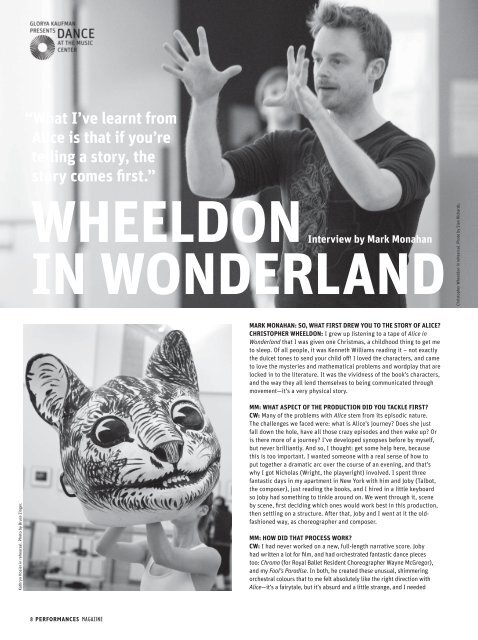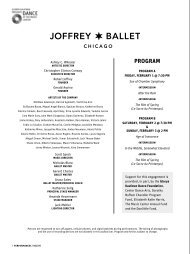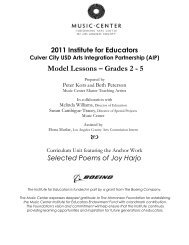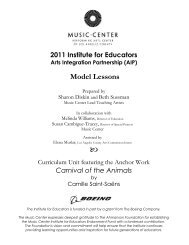alice's adventures in wonderland (2012) program - Music Center
alice's adventures in wonderland (2012) program - Music Center
alice's adventures in wonderland (2012) program - Music Center
Create successful ePaper yourself
Turn your PDF publications into a flip-book with our unique Google optimized e-Paper software.
Kathryn Hosier <strong>in</strong> rehearsal. Photo by Bruce Z<strong>in</strong>ger.<br />
“What I’ve learnt from<br />
Alice is that if you’re<br />
tell<strong>in</strong>g a story, the<br />
story comes first.”<br />
WHEELDON Interview by Mark Monahan<br />
IN WONDERLAND<br />
8 PERFORMANCES MAGAZINE<br />
MARK MONAHAN: SO, WHAT FIRST DREW YOU TO THE STORY OF ALICE?<br />
CHRISTOPHER WHEELDON: I grew up listen<strong>in</strong>g to a tape of Alice <strong>in</strong><br />
Wonderland that I was given one Christmas, a childhood th<strong>in</strong>g to get me<br />
to sleep. Of all people, it was Kenneth Williams read<strong>in</strong>g it – not exactly<br />
the dulcet tones to send your child off! I loved the characters, and came<br />
to love the mysteries and mathematical problems and wordplay that are<br />
locked <strong>in</strong> to the literature. It was the vividness of the book’s characters,<br />
and the way they all lend themselves to be<strong>in</strong>g communicated through<br />
movement—it’s a very physical story.<br />
MM: WHAT ASPECT OF THE PRODUCTION DID YOU TACKLE FIRST?<br />
CW: Many of the problems with Alice stem from its episodic nature.<br />
The challenges we faced were: what is Alice’s journey? Does she just<br />
fall down the hole, have all those crazy episodes and then wake up? Or<br />
is there more of a journey? I’ve developed synopses before by myself,<br />
but never brilliantly. And so, I thought: get some help here, because<br />
this is too important. I wanted someone with a real sense of how to<br />
put together a dramatic arc over the course of an even<strong>in</strong>g, and that’s<br />
why I got Nicholas (Wright, the playwright) <strong>in</strong>volved. I spent three<br />
fantastic days <strong>in</strong> my apartment <strong>in</strong> New York with him and Joby (Talbot,<br />
the composer), just read<strong>in</strong>g the books, and I hired <strong>in</strong> a little keyboard<br />
so Joby had someth<strong>in</strong>g to t<strong>in</strong>kle around on. We went through it, scene<br />
by scene, first decid<strong>in</strong>g which ones would work best <strong>in</strong> this production,<br />
then settl<strong>in</strong>g on a structure. After that, Joby and I went at it the oldfashioned<br />
way, as choreographer and composer.<br />
MM: HOW DID THAT PROCESS WORK?<br />
CW: I had never worked on a new, full-length narrative score. Joby<br />
had written a lot for film, and had orchestrated fantastic dance pieces<br />
too: Chroma (for Royal Ballet Resident Choreographer Wayne McGregor),<br />
and my Fool’s Paradise. In both, he created these unusual, shimmer<strong>in</strong>g<br />
orchestral colours that to me felt absolutely like the right direction with<br />
Alice—it’s a fairytale, but it’s absurd and a little strange, and I needed<br />
Christopher Wheeldon <strong>in</strong> rehearsal. Photo by Sian Richards.<br />
Sonia Rodriguez <strong>in</strong> rehearsal. Photo by Bruce Z<strong>in</strong>ger.<br />
Jonathan Renna and Robert Stephen <strong>in</strong> rehearsal. Photo by Bruce Z<strong>in</strong>ger.<br />
a composer who could take those elements and create a big symphonic<br />
score. His work <strong>in</strong> film has really helped us, because he knows how to<br />
write for character—but then, film is very different from dance, and so for<br />
Joby it was about learn<strong>in</strong>g how to structure a variation for a dancer, and<br />
so on. After those days <strong>in</strong> New York, it was a case of: OK Joby, off you go!<br />
Every step of the way, we were talk<strong>in</strong>g, and he would send me pieces he’d<br />
written. Even go<strong>in</strong>g only by the computerized simulations of the orchestra,<br />
you can tell his score is very vividly drawn, just like the characters <strong>in</strong> the<br />
Carroll. I love it, and it’s accessible too—and that’s important. Alice is a<br />
ballet we hope all sorts of people will come to over a long period.<br />
MM: AND HOW DID YOU APPROACH THE CHOREOGRAPHY?<br />
CW: Most of my work so far has been k<strong>in</strong>d of explor<strong>in</strong>g the abstract.<br />
What I’ve learnt from Alice is that if you’re tell<strong>in</strong>g a story, the story<br />
comes first: your job as a choreographer is of course always to<br />
communicate through movement. But here, above all, it is to convey<br />
the build<strong>in</strong>g-blocks of the story, and then, with<strong>in</strong> that, to explore<br />
vocabulary to def<strong>in</strong>e <strong>in</strong>dividual characters.<br />
MM: THE CARROLL STORY IS NOT WITHOUT ITS DARK SIDE, AND<br />
NOR—IT HAS OFTEN BEEN SUGGESTED—WAS CARROLL HIMSELF. HOW<br />
DID YOU DECIDE ON AN EMOTIONAL ‘REGISTER’ FOR YOUR ALICE?<br />
CW: Well, I did a lot of research on Lewis Carroll, and I do th<strong>in</strong>k there<br />
was some k<strong>in</strong>d of strange, complicated, repressed part of his character.<br />
But there’s certa<strong>in</strong>ly no proof that he ever acted upon it—these creative<br />
people do exist who have a connection with children. I prefer to<br />
believe that Carroll was <strong>in</strong> fact the brilliant storyteller, mathematical<br />
scholar and devout church-man that a lot of people believed he was.<br />
So no, I haven’t gone Freudian with Alice—there’s no MacMillanesque<br />
suicide pact at the end, and nor is there any suggestion of authorial<br />
impropriety. But on the other hand, there is an underly<strong>in</strong>g, scary<br />
darkness to the story. I th<strong>in</strong>k that’s what makes it appeal<strong>in</strong>g for kids,<br />
and we’ve kept that.<br />
MM: SO, WHEN DID YOU ACTUALLY START WORKING ON THE STEPS?<br />
CW: In February of 2010—The Royal Ballet were keen on it be<strong>in</strong>g a yearlong<br />
process. I work very quickly, always have, and that stems from<br />
be<strong>in</strong>g <strong>in</strong> New York and work<strong>in</strong>g at New York City Ballet. Everyth<strong>in</strong>g’s<br />
done quickly there, and that goes back to Balanch<strong>in</strong>e and Robb<strong>in</strong>s: you<br />
make a lot of work, keep some, scrap some. So, the idea of tak<strong>in</strong>g a year<br />
to make a ballet was odd to me. I thought, “Come on guys—I could make<br />
three full-length ballets <strong>in</strong> a year!” As it turned out, The Royal Ballet<br />
just don’t work that way. It was a case of, “You can have one rabbit, <strong>in</strong> a<br />
small studio, for an hour and a half”, and then for three days there’d be<br />
noth<strong>in</strong>g, because they’d be gett<strong>in</strong>g on with Mayerl<strong>in</strong>g or whatever.<br />
MM: WHY SUCH A DIFFERENCE?<br />
CW: In New York, it was bang, bang, bang—you learn a ballet <strong>in</strong> a<br />
day, you’re on <strong>in</strong> the even<strong>in</strong>g. But <strong>in</strong> London, the ballets are big and<br />
<strong>in</strong>volved—you can’t just throw, say, Mayerl<strong>in</strong>g at the stage. Whereas<br />
the Balanch<strong>in</strong>e ballets are about understand<strong>in</strong>g musicality and<br />
choreography, they’re not really about develop<strong>in</strong>g character.<br />
MM: DANCE IS NECESSARILY A COLLABORATIVE DISCIPLINE<br />
BETWEEN CHOREOGRAPHER AND DANCER, BUT TO WHAT EXTENT IS<br />
THIS TRUE FOR YOU?<br />
CW: I never “prep”, never go <strong>in</strong>to a room on my own and create vocabulary<br />
—I love explor<strong>in</strong>g th<strong>in</strong>gs with dancers. But at the same time, Alice is actually<br />
the clearest I’ve ever been. I really knew what I wanted out of this ballet.<br />
MM: WERE YOU TEMPTED TO DANCE IN IT YOURSELF?<br />
CW: Oh no, no… The Duchess is probably the only role I could just about carry off!<br />
This <strong>in</strong>terview is excerpted from The Royal Ballet house <strong>program</strong>me,<br />
courtesy The Royal Opera House.<br />
Mark Monahan is Dance Critic of The Daily Telegraph, London.<br />
PERFORMANCES MAGAZINE 9






